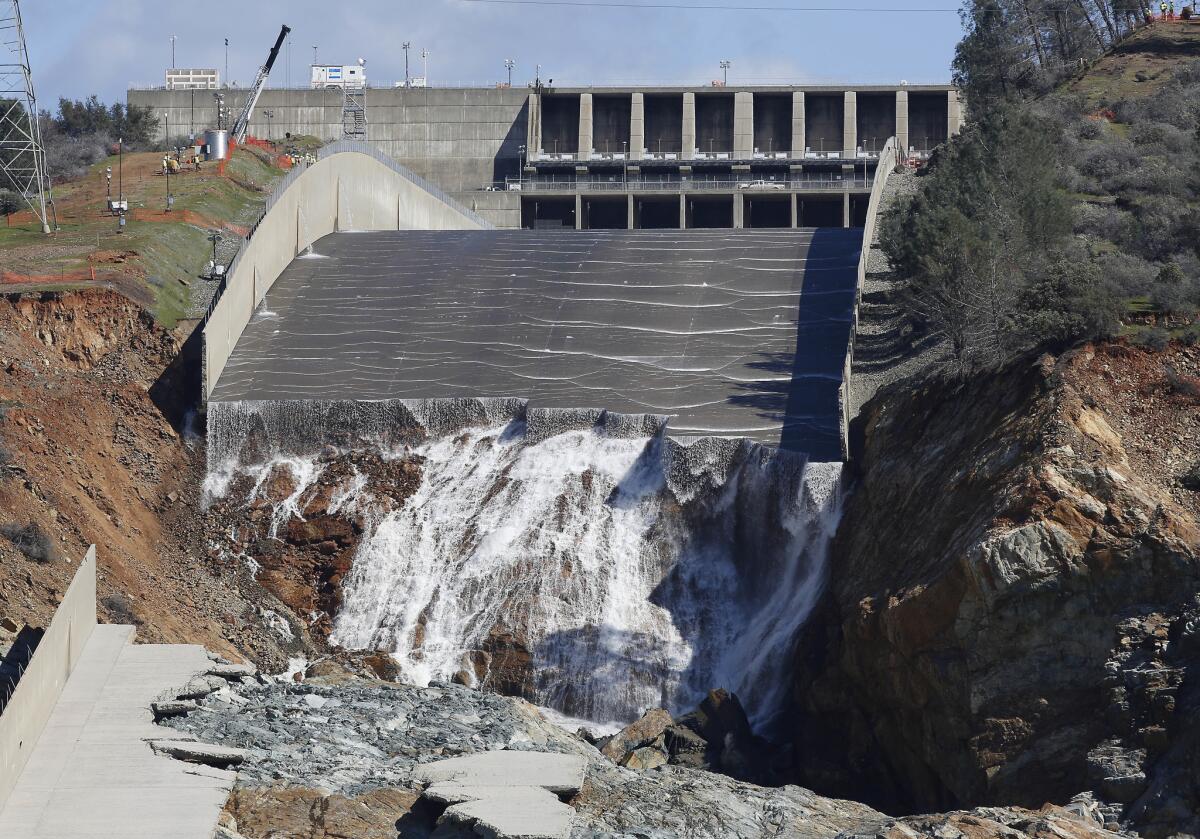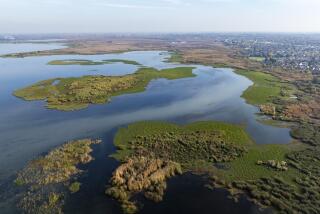Capitol Journal: Will California spend more on water projects? ‘It all depends on how thirsty the governor is,’ De León says

If there ever was a politically ripe time to spend lavishly on water projects, this is it. But Sacramento Democrats are settling for a drop in the bucket.
Spillways got washed out at giant Oroville Dam, forcing more than 100,000 people to flee their homes. Thousands of San Jose residents were flooded out because of raging creeks and inadequate facilities. Houses, barns and roads near the Sacramento-San Joaquin River Delta were swamped.
We’ve had double the normal amount of rain throughout much of the state, ending a five-year drought that wrought havoc because not enough water had been stored in reserve.
Moreover, experts warn this volatile weather pattern has been merely a preview of California life to come with climate change.
So better try to prepare, right? Get those one or two big dams built that everyone has been yakking about for years. Compromise on a real delta plumbing fix; scrub the governor’s impractical, monstrous twin tunnels. Invest heavily in efficient groundwater replenishing, storm water capture and recycling. Expedite desalination. Bolster flood controls.
Why not do some binge-buying? Pay for it with a double-digit water bond?
Answer: Gov. Jerry Brown. He’s a skinflint. He frets about leaving state government with an unmanageable pile of debt when he’s termed out after next year.
That’s why Brown maintains such a high job approval rating with voters. They appreciate his fiscal conservatism. (Except for the extravagant bullet train obsession.) And it’s a big reason why Brown has never lost a race for governor.
The upshot for a water bond: Senate leader Kevin de León (D-Los Angeles) is proposing an underwhelming $3.5-billion water and parks proposal for the June 2018 ballot. Moreover, it’s ultimately expected to be merged somehow with a $3.1-billion bond proposal solely for parks sponsored by Assemblyman Eduardo Garcia (D-Coachella).
De León’s proposal calls for spending $1.5 billion on water projects, excluding dams, $500 million on flood protection and $1.5 billion on parks.
I asked De León whether he envisioned the bond dollar amount eventually increasing given that water has become a hot issue.
“It all depends on how thirsty the governor is,” the Senate leader replied. “To his credit, he’s always fiscally miserly.”
The bond bill will require a two-thirds majority vote of the Legislature and the governor’s signature to put it before voters.
Brown recently told reporters why he’s not a fan of bond borrowing and favors pay-as-you-go financing of public works.
“The trouble with bonds is the interest rates are going to go up,” he said. And he pointed out that loan repayments double a project’s sticker price — something every homebuyer can relate to.
“Bonds can be good,” the governor continued, “and I don’t want to say categorically it’s not a good idea. But in general, we ought to be doing more pay-as-you-go.
“You have a problem? Is it real? You’ve got to pay for it,” Brown said. “What does ‘pay for it’ mean? You’ve got to raise funding. Politically, we’re in a world where opposing government and government spending is very popular. But we still have the fact that public works are needed. So I like the idea of pay-as-you-go. We didn’t have any bonds to build roads when my father was governor. We did a hell of a lot….
“So we’ve got to belly up to the bar and start spending money.”
Gasoline taxes — federal and state — paid for road building in Pat Brown’s day. But vehicles today use a lot less gas, fuel taxes haven’t been keeping up with inflation and the feds have backed off highway spending in recent years.
Grappling with that modern problem and raising the money to repair California’s crumbling highways is the Legislature’s No. 1 issue.
But one way or another, hardly any major government project gets built without bond borrowing. Just like a family taking out a mortgage for a house.
“It’s always easy to borrow,” Brown said. “But a bond is ultimately a tax — a deferred tax. So I think we need the proper balance between putting the burden on the next generation and facing up to the fact that we have to take more of our private capital and put it into public spending.”
The state general fund currently is paying off roughly $75 billion in bonds that have been approved for various purposes. An additional $35 billion worth has been authorized but unsold.
Neither Brown nor the Legislature is likely to find a few spare billions in cash to spend on water projects, let alone parks. So bond financing seems the only realistic option.
But there is $11.8 billion in unsold natural resources bonds available, some of which could be tapped. That includes almost all of a $7.5-billion water bond approved by voters in 2014, although $2.7 billion is reserved for a dam or two. Brown has asked the Legislature to quickly spend $387 million of the bond funds on flood control.
There are also potential Trump dollars. The president has promised a $1-trillion crash program of infrastructure rebuilding.
“And I say, ‘Amen to that, man,’” Brown said in his State of the State address. “We’re there with you.”
It’s a lot easier to spend someone else’s borrowed money. California also should “belly up,” in Brown’s words, and spend more of its own.
Follow @LATimesSkelton on Twitter
ALSO
California’s reservoirs are filled with gunk, and it’s crowding out room to store water
Does California really need more dams? We’re running out of places to put them
More to Read
Get the L.A. Times Politics newsletter
Deeply reported insights into legislation, politics and policy from Sacramento, Washington and beyond. In your inbox three times per week.
You may occasionally receive promotional content from the Los Angeles Times.







